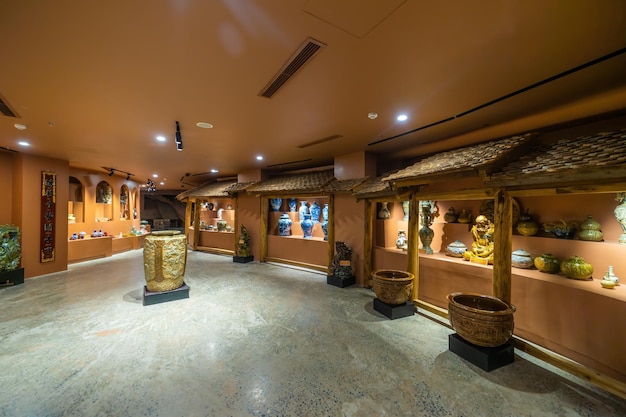News
Exploring the Bat Trang Pottery Museum – A Journey into Vietnam’s Ceramic Heritage
The Bat Trang pottery museum offers an immersive experience into the rich history and artistry of Vietnamese ceramics. Nestled in the heart of the traditional Bat Trang village, this museum showcases centuries of pottery craftsmanship, providing visitors with a unique perspective on cultural heritage and artistic innovation. Whether you are a pottery enthusiast, a cultural explorer, or simply curious, the Bat Trang pottery museum serves as a gateway to understanding the evolution of ceramic art in Vietnam.
Visiting the Bat Trang pottery museum allows you to observe exquisite artifacts, engage with local artisans, and even try your hand at making pottery. This makes it not only a place for learning but also a vibrant cultural exchange hub.
The Historical Significance of Bat Trang Pottery Museum

The Bat Trang pottery museum stands as a testament to one of Vietnam’s oldest ceramic villages, known for its distinct style and longevity.
Before we explore the museum’s collections and activities, it’s essential to understand the historical context that makes Bat Trang pottery so revered.
Origins of Bat Trang Pottery Tradition
Bat Trang’s pottery tradition dates back over 1,000 years, originating during the Ly Dynasty. The village became synonymous with high-quality ceramics due to its advantageous natural resources — rich clay deposits and proximity to the Red River.
This historic legacy is preserved meticulously within the museum, where pieces from different eras trace the development of techniques and styles. Exhibits reveal how Bat Trang artisans blended indigenous methods with external influences, creating a unique fusion that defines their pottery even today.
Evolution Through Dynasties and Trade
Over centuries, Bat Trang pottery evolved under various dynastic rules, including the Tran and Le dynasties, each leaving their distinct mark on the craft.
The museum highlights how trade along the Silk Road introduced new patterns, glazes, and firing techniques. It also emphasizes the role of Bat Trang pottery as both functional ware and decorative art, used widely across Vietnamese society.
Through curated artifacts and informative displays, visitors gain insights into how this evolution mirrored broader cultural exchanges and technological advancements.
Preservation Efforts and Cultural Importance
Preserving Bat Trang pottery is more than conserving objects; it’s about maintaining a living tradition.
The museum actively works with local potters to sustain traditional skills while encouraging innovation. Educational programs and workshops offered here help pass knowledge to younger generations, ensuring the craft remains vibrant.
Furthermore, the museum serves as a cultural landmark, fostering pride among locals and raising awareness globally about Vietnam’s ceramic heritage.
Experiencing the Bat Trang Pottery Museum: What to Expect

A visit to the Bat Trang pottery museum is both educational and interactive, designed to engage a wide variety of audiences.
Understanding what experiences await can help visitors make the most of their journey into the world of ceramics.
Exhibition Highlights and Artistic Collections
The museum showcases thousands of ceramic pieces, ranging from ancient relics to contemporary creations.
Visitors can explore thematic galleries organized by era, style, or function, such as utilitarian wares, ritual items, and ornamental pieces. Detailed narratives explain the significance of each artifact, including production techniques like wheel throwing, glazing, and firing processes.
Special exhibitions often feature collaborations with modern artists who reinterpret traditional motifs, highlighting the dynamic nature of Bat Trang pottery.
Interactive Workshops and Demonstrations
One of the museum’s standout features is its hands-on workshops where guests can practice pottery-making under expert guidance.
These sessions demystify the crafting process, from shaping clay to applying glazes and firing. By participating, visitors gain a deeper appreciation for the skill and patience required.
Live demonstrations by master potters allow visitors to witness the precision and creativity involved, bridging past and present through active engagement.
Navigating the Museum and Visitor Facilities
The museum is thoughtfully designed for accessibility and comfort, with clear signage, multilingual guides, and ample seating areas.
Visitors can also find a gift shop offering authentic Bat Trang pottery products, supporting local artisans directly.
Cafeteria facilities provide traditional refreshments, enhancing the overall cultural immersion. Audio guides and digital resources complement physical displays, catering to diverse learning preferences.
Using Bat Trang Pottery Museum as an Educational Resource

Beyond tourism, the Bat Trang pottery museum serves as a valuable tool for educators, researchers, and cultural advocates.
Leveraging its resources can enhance understanding and promote heritage conservation.
For Art and History Educators
Teachers can utilize the museum’s exhibits and materials to enrich lessons on Asian art, Southeast Asian history, and cultural studies.
Virtual tours and downloadable content enable integration into curricula regardless of geographic limitations.
Field trips offer students tangible connections to theoretical knowledge, fostering curiosity and respect for cultural diversity.
For Researchers and Scholars
The museum houses archives, historical documents, and rare artifacts critical for academic research.
Access to these resources supports studies in archaeology, anthropology, and material culture, contributing to broader scholarship on ceramic technology and trade networks.
Collaborations between the museum and universities facilitate interdisciplinary projects and publications.
For Cultural Preservation Advocates
Non-governmental organizations and community leaders can partner with the museum to develop initiatives promoting Bat Trang pottery’s heritage.
Workshops, exhibitions, and media campaigns raise public awareness and encourage sustainable practices among artisans.
Such efforts reinforce the museum’s role as a cultural steward and advocate for intangible heritage preservation.
Comparing Bat Trang Pottery Museum with Other Pottery Museums Globally
While many countries have museums dedicated to ceramics, Bat Trang pottery museum holds unique characteristics rooted in its cultural context.
Exploring similarities and differences provides fresh perspectives on global ceramic traditions.
Distinctive Features of Bat Trang Pottery Museum
Unlike larger institutions focusing mainly on display, Bat Trang integrates live artisan communities alongside its museum functions.
Its emphasis on ongoing craftsmanship and village life sets it apart, presenting pottery as a living tradition rather than static history.
The scale of the museum complements the intimate connection between artisans and their environment, allowing visitors to witness real-time production.
Similarities with Renowned Pottery Museums Worldwide
Like the Victoria and Albert Museum in London or the National Palace Museum’s ceramic collection in Taiwan, Bat Trang presents comprehensive timelines and artistic narratives.
All these institutions emphasize educational outreach and artistic excellence, fostering global appreciation for ceramics.
Collaborative exchanges and joint exhibitions strengthen international ties and highlight cross-cultural influences.
Lessons from Global Comparisons
By comparing methodologies, Bat Trang pottery museum can adopt innovative technologies such as augmented reality to enhance visitor engagement.
Conversely, other museums might learn from Bat Trang’s integration of community involvement and hands-on workshops as models for preserving craft heritage.
Such cross-pollination benefits the global community of ceramic enthusiasts and cultural custodians alike.
Tips and Advice for Visiting Bat Trang Pottery Museum
To fully enjoy and benefit from your visit to the Bat Trang pottery museum, consider these practical suggestions.
Planning ahead ensures a rewarding and enriching experience.
Best Time to Visit and Duration
The ideal time to visit Bat Trang pottery museum is during weekdays to avoid crowds, especially outside major holidays.
Allocate at least two to three hours to explore exhibitions, participate in workshops, and browse the artisan area without feeling rushed.
Early mornings tend to be cooler, providing a comfortable environment for outdoor activities.
What to Bring and Wear
Comfortable clothing suitable for walking and hands-on activities is recommended.
Bringing a camera (where permitted) helps capture memories and details.
Carrying a notebook or using a smartphone app can assist in recording insights or sketching inspirations from the exhibits.
How to Interact Respectfully
Engage politely with artisans and staff, showing appreciation for their skills and expertise.
Ask permission before photographing people or workspaces.
Avoid touching delicate items unless invited, preserving artifacts for future visitors.
Take advantage of guided tours or audio guides to deepen understanding.
Combining Visits with Local Attractions
Pairing the museum visit with a stroll through Bat Trang village reveals additional cultural gems like traditional markets, pottery shops, and local cuisine.
Nearby scenic spots along the Red River provide relaxing breaks and photo opportunities.
Together, these experiences offer a holistic view of the region’s lifestyle and heritage.
Conclusion
The Bat Trang pottery museum is more than a repository of ceramic artifacts—it is a vibrant cultural hub celebrating the enduring art of pottery in Vietnam. Through its rich historical collections, interactive workshops, and commitment to preservation, the museum offers visitors a multifaceted exploration of craftsmanship, heritage, and community. Whether compared to other global pottery museums or approached as an educational resource, Bat Trang pottery museum stands out for its living traditions and deep-rooted cultural significance. Planning your visit with thoughtful preparation will ensure an unforgettable journey into the heart of Vietnam’s ceramic artistry.
